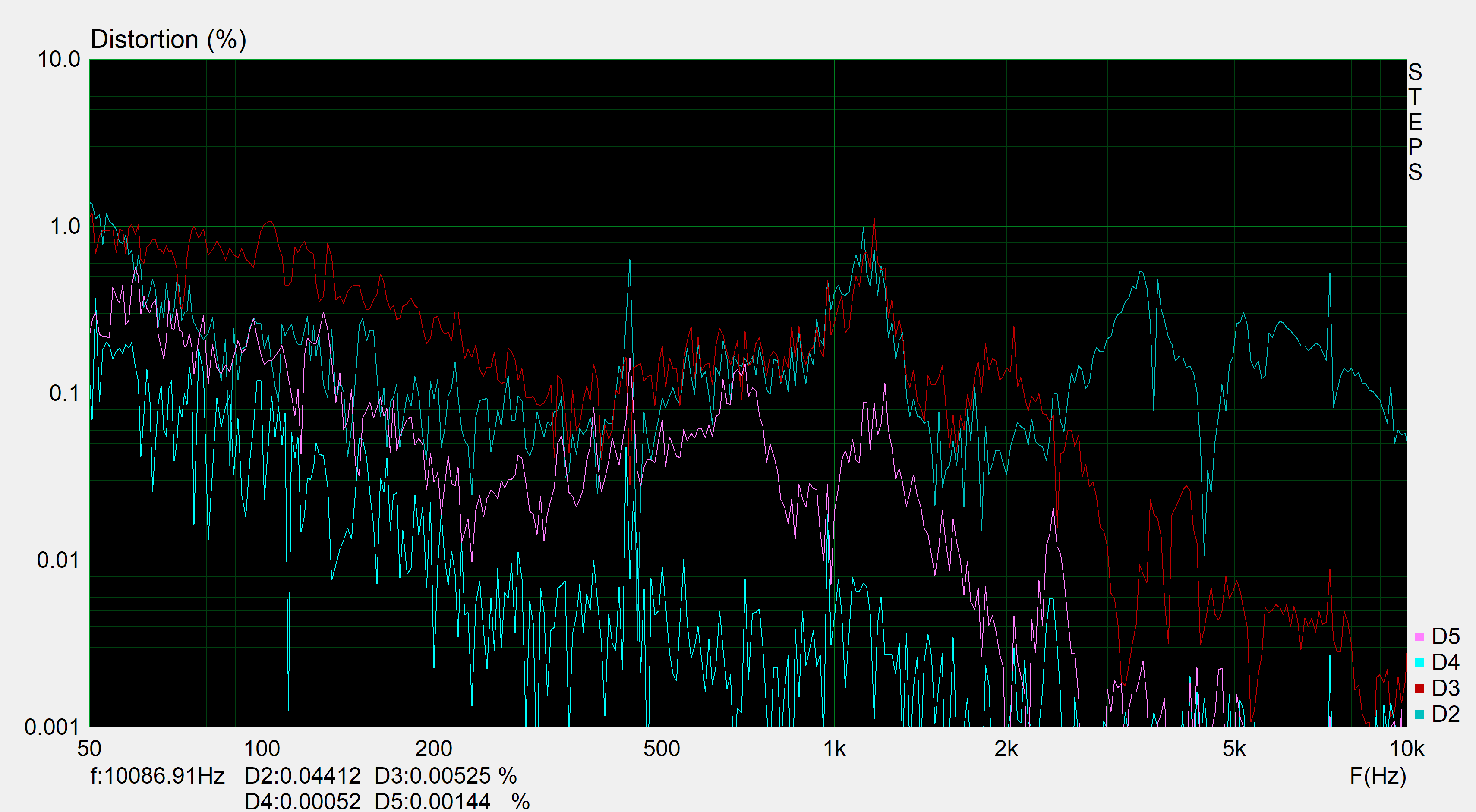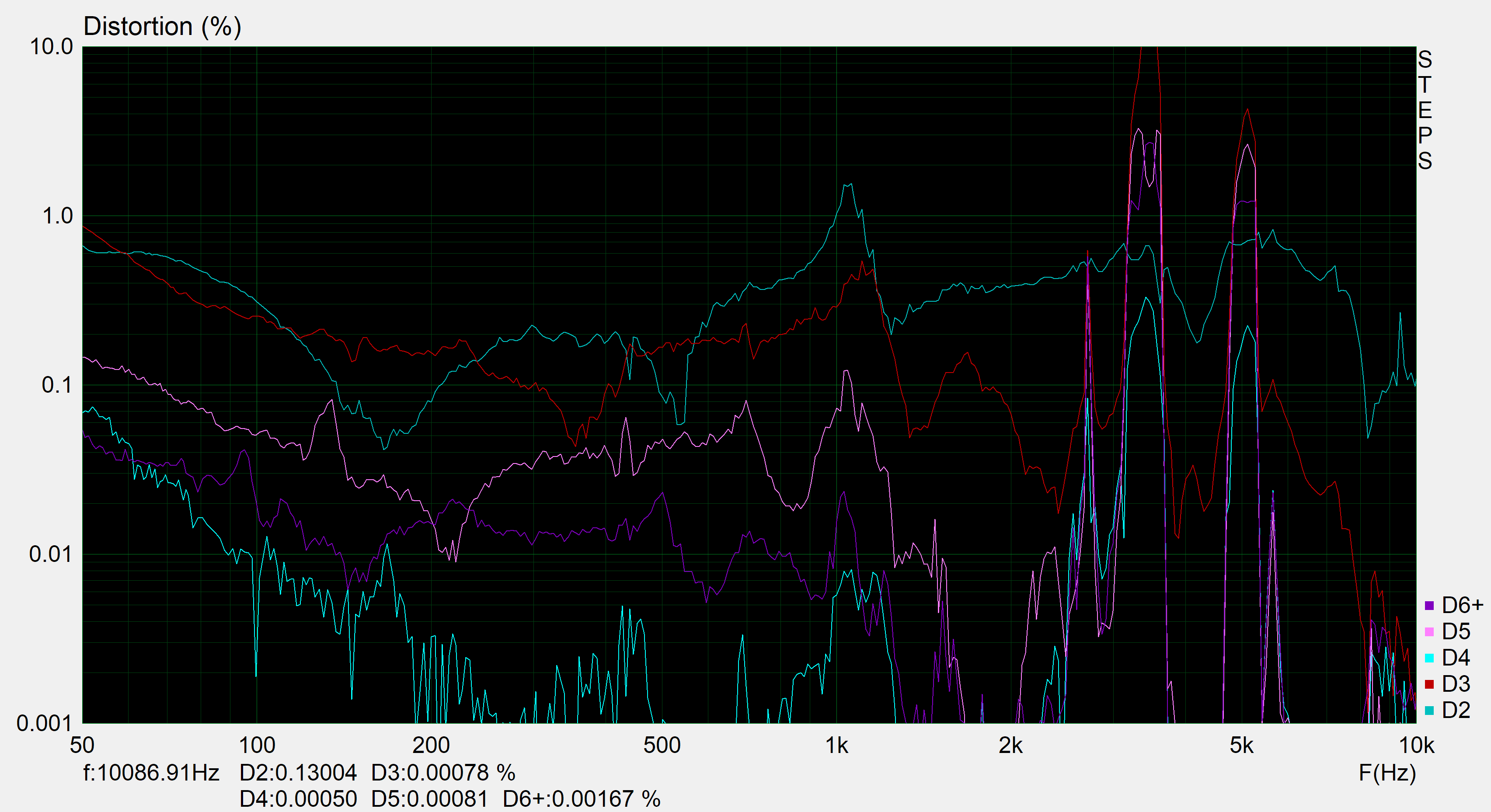BWX-6502

Here we have a much less well known driver. As far as I know this goes for the DIY community as well as the commercial sector. I have never seen a commercially available speaker with one of these in, nor a DIY speaker for that matter, but Bold North Audio are still in business so someone must be buying their drivers!
Needless to say if you're after a long excursion, 6.5", bass driver there aren't that many options and these options shrink even more if you want good lower midrange performance too. Sure you can go to Aliexpress, and find a bunch of potential candidates, as much as the car audio sector, but things like Klippel verified excursion, and large amounts of copper in the motor, are nowhere to be found.
Sure you've got the likes of Scanspeak's Illumintors, as well as offerings from Purifi, but these are very expensive and this becomes increasingly more important if you want to use several per speaker. The BWX-6502 is far more cost effective than either of those so this is what we have here.
Needless to say if you're after a long excursion, 6.5", bass driver there aren't that many options and these options shrink even more if you want good lower midrange performance too. Sure you can go to Aliexpress, and find a bunch of potential candidates, as much as the car audio sector, but things like Klippel verified excursion, and large amounts of copper in the motor, are nowhere to be found.
Sure you've got the likes of Scanspeak's Illumintors, as well as offerings from Purifi, but these are very expensive and this becomes increasingly more important if you want to use several per speaker. The BWX-6502 is far more cost effective than either of those so this is what we have here.
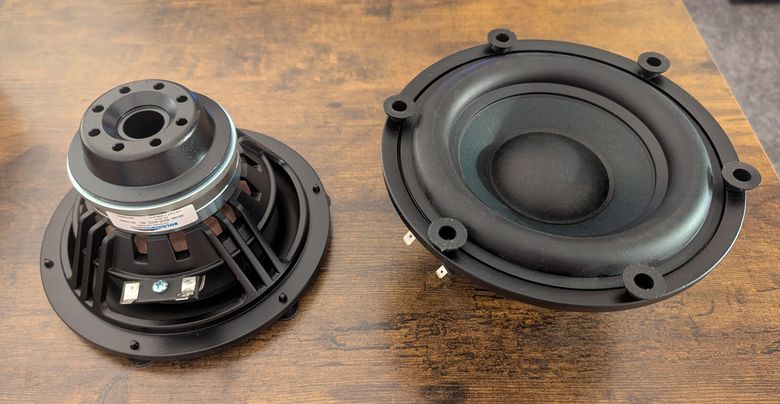
These are very well built drivers with attention to detail everywhere you could ask for. Wide open cast baskets with plenty of under spider ventilation as well as a gigantic pole vent. A neodymium motor, to keep the weight down, as well as to provide the field strength for the less efficient, licensed, XBL2 motor geometry. Plenty of copper in the motor, giving this driver an impressively low inductance of 0.2mH, as well as a hugely bumped back plate to allow for large excursions. The back plate also having a series of holes within it for additional voice coil ventilation, to increase power handling, and to reduce power compression.
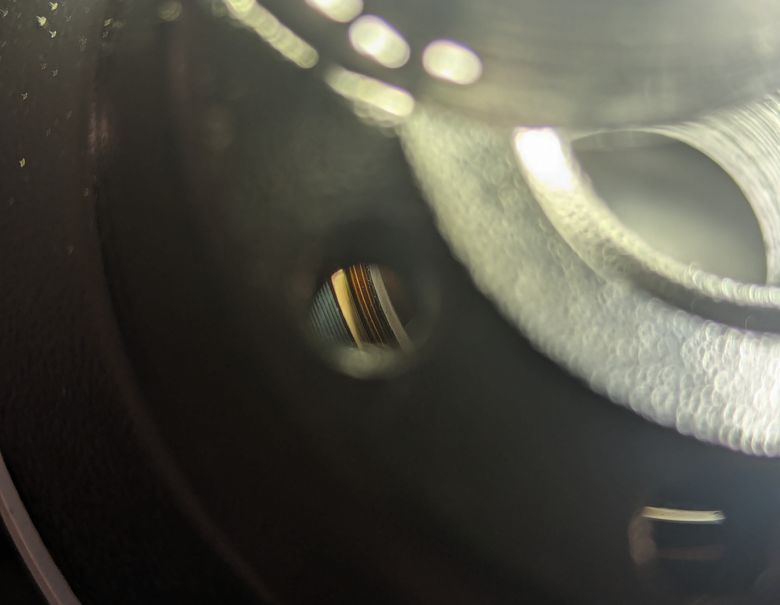
Above is an image attempting to capture a shot of the voice coil through one of the vents in the back plate. You can just about make out some of the windings as well as, what appears to be, a thick copper ring going through the gap.
The first thing to mention is that these were tested in the cabinets pictured below. These are passive cardioid cabinets and therefore have slots down the sides lined with a layer of stuffing.
The first thing to mention is that these were tested in the cabinets pictured below. These are passive cardioid cabinets and therefore have slots down the sides lined with a layer of stuffing.
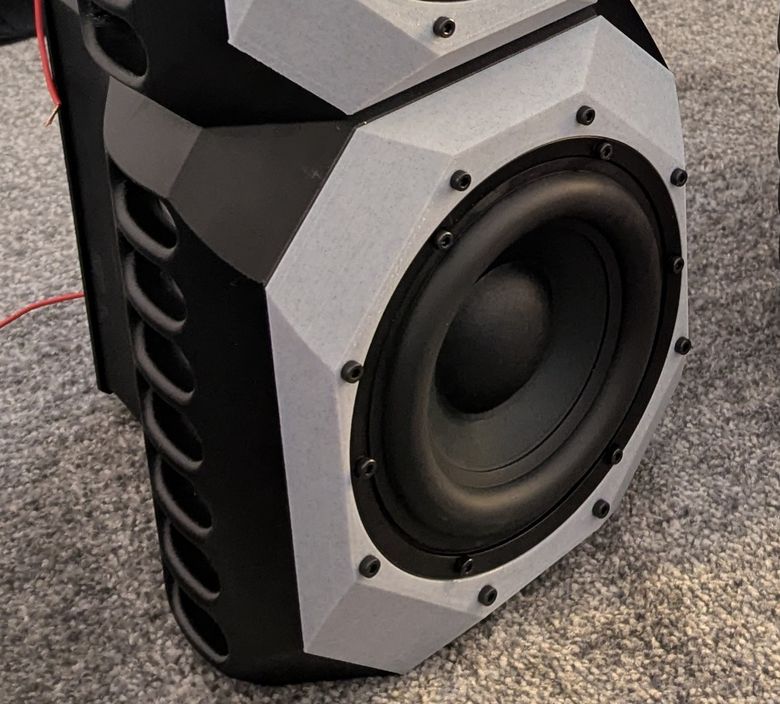
First up are two frequency response measurements. The first is at a distance of 60cm complete with cabinet diffraction and a lower end showing the cardioid response. Take from that what you will but the important aspects of this measurement are to highlight the large dip just above 1kHz and the sizeable break up at 3.5kHz. Make no mistake this is not a driver that has been engineered for typical mid/bass use.
The second measurement, taken at 2cm from the dust-cap, shows the same limitations as the far field but gives a much better representation of the bass performance. The near field measurement ignoring the cancellation of the cardioid cabinet and showing a flat response from 800Hz and down.
The second measurement, taken at 2cm from the dust-cap, shows the same limitations as the far field but gives a much better representation of the bass performance. The near field measurement ignoring the cancellation of the cardioid cabinet and showing a flat response from 800Hz and down.
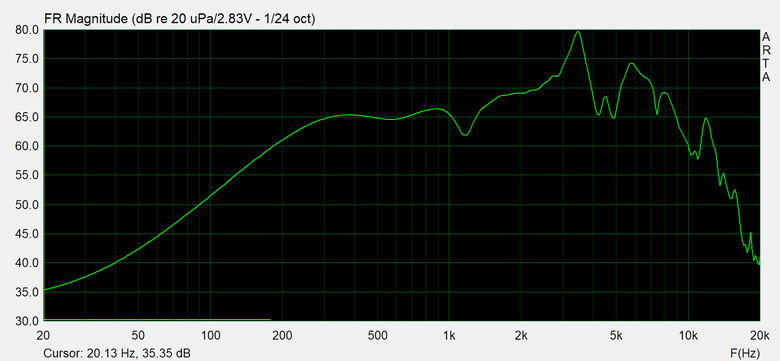
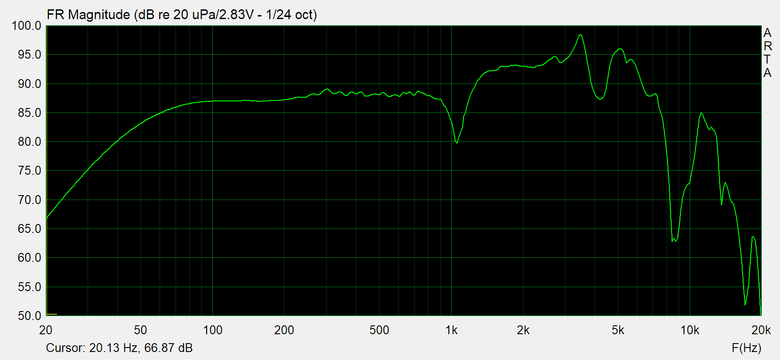
Next are two distortion measurements taken at 30cm away from the dust cap. The first is done at 2.85VRMS, so roughly 83dB for this driver, and then the second at +10dB, so 93dB.
The first thing to point out is that the spike around 400Hz is not the driver but something in the room vibrating. Irritating but I'm sure you can all imagine the graph without the spike.
Second is that distortion is impressively low until you hit the spike around 1kHz. But lets have a look at a near field distortion measurement as this will eliminate any increase in distortion due to the cardioid cabinets effect on things.
Second is that distortion is impressively low until you hit the spike around 1kHz. But lets have a look at a near field distortion measurement as this will eliminate any increase in distortion due to the cardioid cabinets effect on things.
This was taken back at 2.85VRMS otherwise it would have overloaded the microphone. As you can see the microphone clipped when the driver went through break up. As I am measuring with one of the, older model, ECM8000 Behringer mics you can also see the higher levels of HD2 in the near field Vs the far field. These microphone capsules are good for about 95dB and then their HD2 self distortion shoots up. 83dB at one metre is around 115dB at 2cm so we're definitely getting mic distortion here.
Either way extremely low levels of HD4 and low levels of HD2 when looking at the far field plot for HD2. HD3 and HD5 are both low as well but slightly higher than you might expect. This is somewhat typical for XBL2 motors and is also similar behaviour to the underhung ScanSpeak Illuminator 6.5" drivers. From what I understand this is due to the magnetic gaps of both motors being particularly tall. XBL2 with its dual gap and thick top plate/pole and the underhung Scans having a very thick top plate/pole piece too. This increases hysteresis distortion within the materials and gives rise to higher odd order distortion Vs a typical overhung motor.
It's of no real consequence to the BWX-6502 or Illuminators usability though. They've both got low distortion and gobs of linear excursion and for the bottom of a three way, or a slim-line cardioid in my case, having lots of linear excursion to play with is essential.
I have two minor criticism for this driver and the first is the mess just above 1kHz. This could have been completely avoided had a metal cone been used and, given the cone diameter, a metal cone would have resulted in its first major break up occurring at about 5kHz+. This would have increased the frequencies of all the distortion peaks and given the driver usability up to around 1kHz. It won't make any difference to my application but it would have resulted in a slightly better driver.
The second criticism is that the Qts of this driver is 0.61 although its Vas is tiny. It will work well in sealed cabinets but that's about it. Interestingly Vance Dickason, at audioXpress, measured much lower values of around 0.47. This is much more useful and could be ported.
Either way extremely low levels of HD4 and low levels of HD2 when looking at the far field plot for HD2. HD3 and HD5 are both low as well but slightly higher than you might expect. This is somewhat typical for XBL2 motors and is also similar behaviour to the underhung ScanSpeak Illuminator 6.5" drivers. From what I understand this is due to the magnetic gaps of both motors being particularly tall. XBL2 with its dual gap and thick top plate/pole and the underhung Scans having a very thick top plate/pole piece too. This increases hysteresis distortion within the materials and gives rise to higher odd order distortion Vs a typical overhung motor.
It's of no real consequence to the BWX-6502 or Illuminators usability though. They've both got low distortion and gobs of linear excursion and for the bottom of a three way, or a slim-line cardioid in my case, having lots of linear excursion to play with is essential.
I have two minor criticism for this driver and the first is the mess just above 1kHz. This could have been completely avoided had a metal cone been used and, given the cone diameter, a metal cone would have resulted in its first major break up occurring at about 5kHz+. This would have increased the frequencies of all the distortion peaks and given the driver usability up to around 1kHz. It won't make any difference to my application but it would have resulted in a slightly better driver.
The second criticism is that the Qts of this driver is 0.61 although its Vas is tiny. It will work well in sealed cabinets but that's about it. Interestingly Vance Dickason, at audioXpress, measured much lower values of around 0.47. This is much more useful and could be ported.
